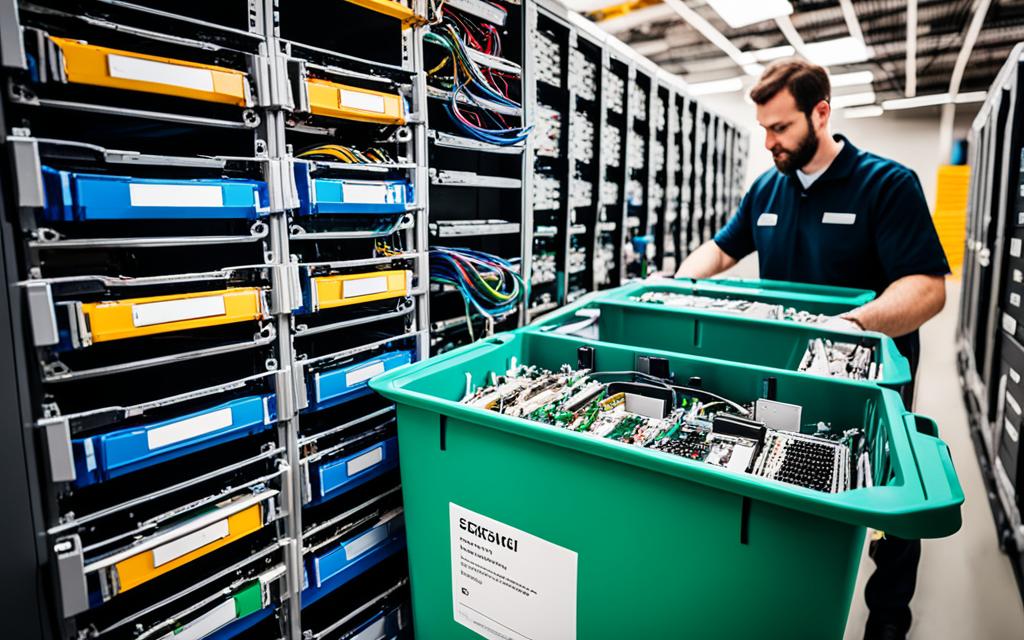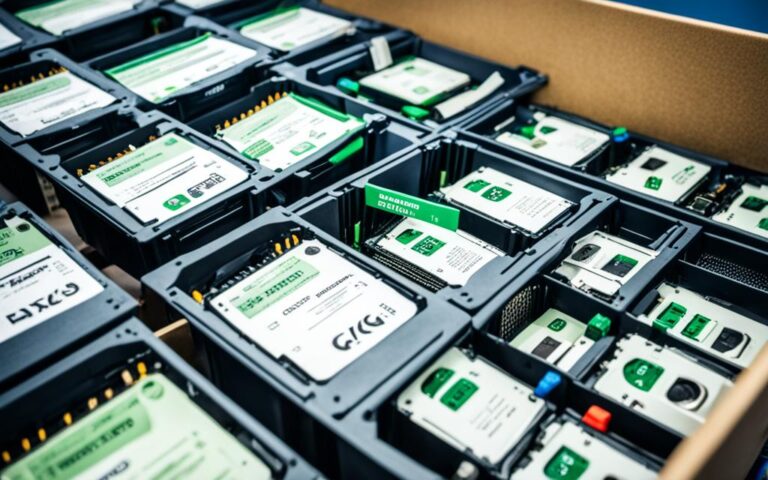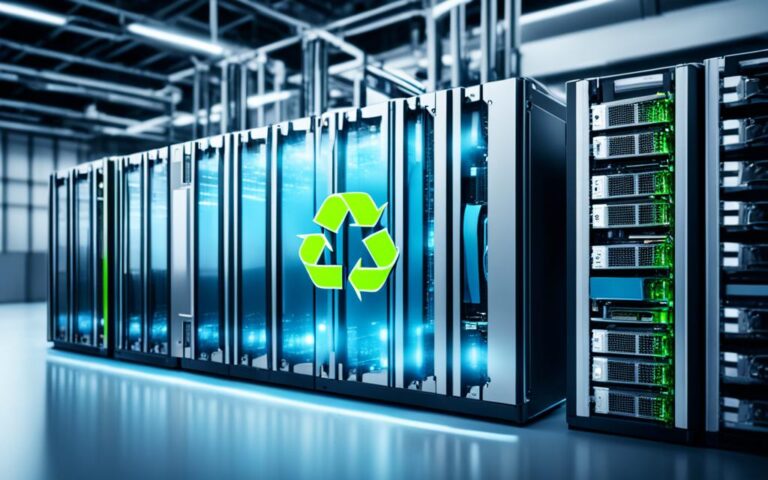Data Security: Ensuring Safe Data Destruction in Server Recycling
When it comes to server recycling, data security should be a top priority. Properly wiping and destroying sensitive data from hard drives is crucial to maintain confidentiality and comply with regulations. The consequences of not taking data security seriously can be detrimental to businesses.
In this article, we will explore the importance of secure data destruction in server recycling and the methods that companies can choose to ensure data confidentiality. We will also discuss the significance of auditing inventory and adopting sustainable practices in IT asset disposition.
Securing your data is vital to protect your business, your clients, and your reputation. With proper data destruction, you can confidently recycle your servers, knowing that all sensitive information has been permanently erased.
Let’s dive into the details of server data destruction, data security, and server recycling to understand how to safeguard your valuable data effectively.
The Importance of Secure Data Destruction
In today’s digital world, secure data destruction is of paramount importance for businesses. Safeguarding sensitive information and protecting data assets are crucial for maintaining a strong reputation and avoiding potential fines. By utilizing secure data destruction methods such as software erasure or physical destruction, companies can ensure the confidentiality of their data, safeguard their networks and infrastructure, and comply with government security services.
Ensuring the security of data information is vital for maintaining the trust of clients and customers. With the increasing prevalence of cyber threats, businesses must take all necessary precautions to protect their networks from unauthorized access. Secure data destruction goes beyond simply deleting files or formatting drives; it involves permanently eradicating data from storage devices to make it irretrievable.
One of the primary methods for secure data destruction is software erasure. This process involves overwriting the data multiple times with random characters, rendering the original information unreadable and unrecoverable. Software erasure is effective for securely disposing of data stored on hard drives, solid-state drives (SSDs), and other storage media.
In cases where software erasure is not feasible or when an added layer of security is required, physical destruction of storage devices becomes necessary. Physical destruction methods include shredding, crushing, or disintegration of the devices, rendering them completely unusable and permanently destroying the data they contain.
Protecting sensitive information goes beyond a legal obligation – it is an ethical responsibility that businesses must prioritize. The potential consequences of data breaches or leaks can be severe, including financial losses, brand damage, and legal repercussions.
Certified data destruction services provide businesses with the assurance of proper and secure disposal of their data. These services adhere to strict protocols, ensuring that confidential information is irretrievably destroyed and compliant with government security regulations. Obtaining a certificate of data destruction from a certified service provider not only provides documented proof of compliance but also instills confidence in customers and stakeholders.
In conclusion, the importance of secure data destruction cannot be overstated. It not only helps businesses maintain their reputation and avoid fines but also safeguards their networks, infrastructure, and sensitive information. By employing secure data destruction methods, businesses can protect themselves from potential cyber threats, comply with legal requirements, and demonstrate their commitment to data information security and protected networks.
The Role of Certified Data Destruction Services
Certified data destruction services play a crucial role in ensuring the secure disposal of data. These services employ industry-standard practices and follow strict protocols to guarantee the complete eradication of information from storage devices. By partnering with certified service providers, businesses can benefit from:
- Expertise in secure data destruction methods
- Compliance with government security regulations
- Documentation and certificates of data destruction
- Peace of mind for customers and stakeholders
Choosing the Method for Data Destruction
In the process of data destruction, companies are faced with the decision of choosing the most suitable method. Two commonly employed approaches are data wiping and physical destruction, each with its own advantages and considerations.
Data Wiping
Data wiping involves overwriting the information on storage devices with pseudo-random data, effectively eliminating any trace of the original data. This method ensures that confidential data cannot be recovered, providing a high level of security.
By employing data wiping, companies can protect their sensitive information and comply with data security regulations. This method is particularly beneficial when sensitive data needs to be retained for future use or when repurposing the storage devices is a possibility.
Physical Destruction
On the other hand, physical destruction renders the drives unusable, making it impossible to retrieve any information contained within. This method involves processes such as shredding or crushing the equipment, ensuring that the data is irreversibly destroyed.
Physical destruction is often chosen when absolute data eradication is paramount and when there are no concerns about the potential reuse or repurposing of the storage devices. It provides a sense of certainty that sensitive data cannot be accessed by unauthorized individuals.
When deciding between data wiping and physical destruction, companies should consider their specific requirements, including the level of security needed, the potential for reuse or repurposing, and adherence to data protection regulations.
“Data wiping and physical destruction are both viable methods, and the choice ultimately depends on the nature of the data and the company’s specific needs.”
“Data wiping and physical destruction are both viable methods, and the choice ultimately depends on the nature of the data and the company’s specific needs.”
Companies may also consider combining both methods, employing data wiping as a primary approach while using physical destruction as a final measure to ensure complete eradication.
It’s important to note that when choosing a method for data destruction, businesses should consider partnering with certified service providers that specialize in secure data disposal. These providers can offer expert guidance, ensure compliance with regulations, and provide certificates of data destruction as proof of proper disposal.
| Method | Advantages | Considerations |
|---|---|---|
| Data Wiping | – Retains the option for future use of storage devices – Allows for potential reuse or repurposing of devices |
– Time-consuming process – Requires proper implementation to ensure complete eradication |
| Physical Destruction | – Renders data irrecoverable – Provides a high level of certainty in data destruction |
– Eliminates the potential for reuse or repurposing of devices – Requires specialized equipment or services for proper execution |
Ultimately, the choice between data wiping and physical destruction should be made based on a careful evaluation of the company’s specific needs and the nature of the data to be destroyed. By selecting the most appropriate method, companies can ensure the safe and secure disposal of sensitive information.
Ensuring Audit of Inventory
To ensure the proper disposal of IT assets and equipment, companies must prioritize internal processes and conduct thorough audits of their outgoing inventory. By implementing effective inventory management strategies and following strict guidelines, organizations can achieve compliance satisfaction and ensure the secure disposal of sensitive data.
One crucial aspect of ensuring an audit of inventory is the implementation of unique codes for tracking IT assets. These codes allow companies to accurately monitor the movement and status of each asset throughout its lifecycle. By tracking the assets from acquisition to disposal, organizations can identify any potential vulnerabilities and take appropriate actions to mitigate risks.
Guaranteeing that all IT assets are processed appropriately during disposal is another key factor in the audit of inventory. This involves adhering to established protocols and conducting rigorous checks to ensure that all data is securely erased or destroyed. By following these procedures, companies can not only protect sensitive information but also comply with data protection regulations and industry standards.
The Benefits of an Audit of Inventory
An audit of inventory offers numerous benefits to organizations, ranging from legal compliance to streamlining internal processes and enhancing overall data security. Here are some key advantages:
- Compliance Satisfaction: By conducting regular audits of inventory, companies can demonstrate their commitment to compliance with data protection laws and regulations. This helps build trust with stakeholders and ensures that the organization operates within legal boundaries.
- Improved Internal Processes: An audit of inventory enables companies to identify any gaps or inefficiencies in their IT asset management processes. By addressing these issues, organizations can streamline their operations, reduce costs, and improve overall productivity.
- Enhanced Data Security: Through the audit process, companies can identify potential vulnerabilities or breaches in their data security measures. By addressing these issues promptly, organizations can strengthen their data protection measures, safeguard confidential information, and protect their reputation.
“An effective audit of inventory ensures that companies maintain control over their IT assets, comply with regulations, and mitigate potential risks. It is a crucial step in guaranteeing the secure disposal of sensitive data and minimizing the impact of data breaches.” – Jennifer Thompson, IT Security Consultant
By following the principles of inventory management and conducting regular audits, companies can confidently demonstrate compliance with data protection regulations, maintain the integrity of their internal processes, and protect sensitive information throughout the entire asset lifecycle.
Sustainable IT Asset Disposition
Sustainable IT asset disposition is becoming increasingly important for organizations. By recycling IT equipment, companies can reduce electronic waste and minimize their impact on the environment. Proper disposal methods, such as reusing or repurposing devices, can contribute to corporate sustainability and positive management of the company’s image. Partnering with certified recycling services ensures responsible handling of materials and compliance with e-waste laws.
Electronic waste, or e-waste, poses significant environmental challenges. The rapid advancement of technology leads to a constant stream of outdated IT equipment that needs to be disposed of properly. Discarding e-waste in landfills or incinerating it contributes to pollution and the release of harmful substances into the environment.
Minimizing Environmental Impact
IT equipment recycling aims to mitigate the harmful effects of electronic waste. By recycling or donating outdated devices, companies can ensure valuable resources are conserved and toxic components are properly treated. This reduces the need for extracting new raw materials and prevents hazardous substances from entering landfills or contaminating water sources. Initiating a comprehensive IT equipment recycling program demonstrates a commitment to environmental responsibility and sustainable business practices.
Responsible Handling and Compliance
Partnering with certified recycling services is crucial to ensure responsible handling of IT equipment. These services specialize in the proper disposal of electronic waste and adhere to strict environmental and data security regulations. They have the necessary infrastructure and expertise to safely dismantle and recycle various components, including batteries, circuit boards, and plastics. Compliance with e-waste laws helps companies avoid fines and demonstrates their commitment to ethical and legal practices.
“Sustainable IT asset disposition is not just a legal requirement; it is an opportunity for companies to make a positive impact on the environment and their reputation.”
Educating Employees and Stakeholders
Implementing sustainable IT asset disposition practices requires the active involvement of employees and stakeholders. Raising awareness about the importance of recycling IT equipment and providing education on proper disposal methods can foster a culture of environmental responsibility within the organization. By engaging employees in the recycling process, companies can create a sense of shared responsibility and empower individuals to contribute to the company’s sustainability goals.
Maximizing Value through Reuse and Repurposing
Alongside recycling, companies can explore opportunities to maximize the value of IT equipment through reuse and repurposing. Devices that are still functional but no longer needed by the organization can be refurbished and donated to schools, non-profit organizations, or communities in need. This not only reduces electronic waste but also extends the lifespan of IT equipment, maximizing its value and creating positive social impact.
| Benefits of IT Equipment Recycling | Benefits of Reuse and Repurposing |
|---|---|
| – Reduces electronic waste and its environmental impact | – Extends the lifespan of IT equipment |
| – Conserves valuable resources by recycling components | – Maximizes the value of IT assets |
| – Prevents hazardous substances from entering landfills | – Creates positive social impact through donations |
| – Compliance with e-waste laws and regulations | – Fosters a culture of sustainability within the organization |
Best Practices for Secure Data Disposal
Secure data disposal is a critical process in protecting sensitive information and ensuring compliance with data security regulations. To achieve effective data disposal, companies should adopt best practices that encompass data wiping, degaussing, physical destruction, and data erasure.
Data Wiping
Data wiping is a software-based method that safeguards against data breaches by overwriting all data on storage devices. Through multiple rounds of overwriting with random or patterned data, data wiping ensures that no trace of the original information remains. This method is highly effective in eliminating the possibility of data recovery, providing peace of mind and security to businesses.
Degaussing
Degaussing is another powerful technique used to render hard drives and magnetic media unreadable. By subjecting the storage media to a powerful magnetic field, degaussing erases all data stored on the devices. This method is particularly useful for organizations handling a large volume of magnetic media and requires a certified degaussing device for optimal results.
Physical Destruction
In situations where data wiping or degaussing may not be feasible or practical, physical destruction offers a reliable solution. Physical destruction involves physically damaging the storage devices, making it impossible to retrieve any data. From shredding hard drives to crushing them into tiny pieces, physical destruction ensures complete and irreversible destruction of the data-bearing media.
“Secure data disposal is not just about deleting information. It’s about ensuring that the data is beyond recovery, protecting both your business and your clients from potential threats.” – Alex Thompson, IT Security Consultant
Certificate of Data Destruction
When outsourcing data disposal services to certified providers, it’s important to obtain a certificate of data destruction. This certificate serves as documented proof that the data destruction process was carried out in compliance with industry standards, ensuring companies can fulfill the necessary compliance documentation requirements.
Remember, secure data disposal is a vital component of data security and compliance. By implementing best practices such as data wiping, degaussing, physical destruction, and obtaining a certificate of data destruction, businesses can safeguard sensitive information, minimize the risk of data breaches, and remain compliant with regulations.
| Data Destruction Method | Benefits |
|---|---|
| Data Wiping | – Ensures complete eradication of data – Cost-effective method – Preserves the functionality of storage devices |
| Degaussing | – Eliminates the possibility of data recovery – Suitable for large volumes of magnetic media – Certified degaussing devices provide optimal results |
| Physical Destruction | – Renders data physically irretrievable – Suitable for situations where wiping or degaussing is not feasible – Provides peace of mind and data security |
Conclusion
Data security plays a pivotal role in the server recycling process. It is crucial for businesses to prioritize secure data destruction to safeguard sensitive information effectively. By implementing best practices for data disposal and adopting sustainable IT asset disposition, companies can contribute to environmental responsibility while ensuring compliance with regulations.
When it comes to server data destruction, choosing the appropriate method is vital. Whether it’s data wiping, physical destruction, or degaussing, companies must select the most suitable approach that aligns with their specific requirements. This ensures that all confidential data is permanently eliminated, reducing the risk of unauthorized access and potential data breaches.
Furthermore, conducting an audit of inventory is essential to ensure that all IT assets are disposed of properly. By implementing robust internal processes and tracking outgoing inventory, companies can maintain compliance satisfaction and demonstrate their commitment to responsible data management.
In today’s digital age, it is not just about protecting data; it’s also about being environmentally conscious. Sustainable practices in IT asset disposition, such as recycling and repurposing equipment, contribute to reducing electronic waste and minimizing the carbon footprint. By partnering with certified recycling services, companies can ensure that their IT assets are handled responsibly, promoting a positive corporate image and showcasing their commitment to environmental stewardship.
FAQ
Why is data security important in server recycling?
Data security is crucial in server recycling to protect confidential information and comply with regulations. Safely wiping and destroying data from hard drives ensures confidentiality and avoids fines.
What are the benefits of secure data destruction?
Secure data destruction helps businesses maintain their reputation, protect their networks and infrastructure, and ensure compliance with government security services. It provides assurance that confidential data can never be accessed again.
What methods can companies choose for data destruction?
Companies can choose between data wiping and physical destruction. Data wiping involves overwriting the information on storage devices, while physical destruction renders the drives unusable through shredding or crushing.
How can companies ensure proper disposal of IT assets and equipment?
Companies need to align their internal processes with auditing of outgoing inventory. By keeping track of IT assets through unique codes and ensuring proper processing, companies can achieve compliance satisfaction and receive certificates of data destruction.
Why is sustainable IT asset disposition important?
Sustainable IT asset disposition reduces electronic waste and minimizes the impact on the environment. Proper disposal methods, such as reusing or repurposing devices, contribute to corporate sustainability and positive management of the company’s image.
What are the best practices for secure data disposal?
Best practices include data wiping using software-based methods, degaussing to demagnetize hard drives, and physical destruction through shredding. Obtaining a certificate of data destruction from a certified service provider is important for compliance documentation.
Why should businesses follow best practices for secure data disposal?
Following best practices ensures compliance with regulations, protects sensitive data, and contributes to environmental sustainability. It helps businesses maintain their reputation and avoid fines for non-compliance.













